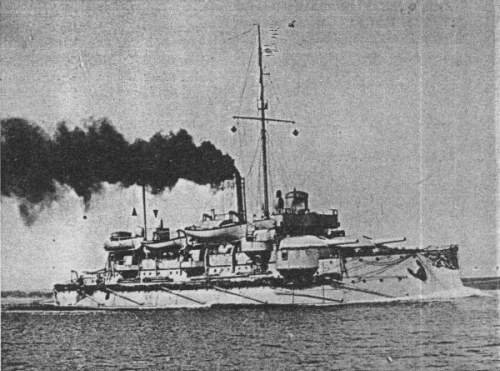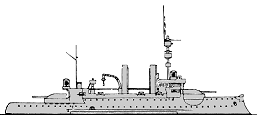
NAVYPEDIA
 Support the project with paypal
Support the project with paypal
Photo

Hagen 1894
Ships
| Name | No | Yard No | Builder | Laid down | Launched | Comp | Fate |
|---|---|---|---|---|---|---|---|
| Odin | Danzig KW | 1893 | 3.11.1894 | 22.9.1896 | depot ship 1917 | ||
| Ägir | 22 | Kiel KW | 1892 | 3.4.1895 | 15.10.1896 | accommodation hulk 1916 |
Technical data
| Displacement normal, t | 3691 |
|---|---|
| Displacement full, t | 3750 |
| Length, m | 79.0 oa 76.4 wl |
| Breadth, m | 15.2 |
| Draught, m | 5.61 |
| No of shafts | 2 |
| Machinery | 2 VTE, 8 Thornycroft boilers |
| Power, h. p. | Odin: 4650 Ägir: 5120 |
| Max speed, kts | Odin: 14.4 Ägir: 15 |
| Fuel, t | coal 370 |
| Endurance, nm(kts) | 2200(10) |
| Armour, mm | belt: 220 - 120, barbettes and cupolas: 200 - 30, deck: 70 - 50, CT: 120 |
| Armament | 3 x 1 - 238/32 MRK L/35 C/88, 10 x 1 - 88/27 SK L/30 C/89, 3 - 450 TT (1 bow, 2 beam) |
| Complement | 276 |
Standard scale images

Odin 1910

Ägir 1897
Graphics
Project history
These small armoured ships, intended for the defence of the approaches to German harbours, had an unusual distribution of their main armament, the two forward turrets being mounted side by side. The last two ships, besides the different armament and Ägir`s two funnels, differed from the others in their armour protection and also in having fighting tops.
Ship protection
Krupp steel armour was used. Main belt protected only citadel between main barbettes and consisted of 220mm upper strip backed by 180mm wood and 120mm lower strip backed by 280mm wood. There was 70-50mm armoured deck. Barbettes and cupolas had 200-30mm armour on 200mm wooden layer, CT had 120mm sides and 30mm roof.
Modernizations
(1901-1903, Danzig KW), Odin; (1903-1904, Danzig KW), Ägir: were completely rebuilt: 4158t (normal) / 4236-4436t (full load), 86.2(oa) 84.8(wl) x 15.4 x 5.60m, 5000(Odin) or 5600(Ägir)hp, 15.5kts, 580t of coal and 100t of oil, 3000(10)nm, complement: 307; + 1 - 450 TT (stern)
Naval service
In 1915 this class were reclassified as coastal defence ships after a brief attachment to the fleet, but a year later all were disarmed. Their histories, after being removed from service and sold in 1919, are more than usually interesting. It was planned to convert Siegfried to a salvage ship, but this fell through and she was broken up in 1920. Beowulf had briefly been used as an icebreaker before being sold, but was broken up in 1921. Frithjof was rebuilt in 1923 as a motor cargo ship, and not broken up till 1930. A conversion of Heimdall into a salvage ship never materialized and she was broken up in 1921. Hildebrand was towed away to Holland for breaking up, but was wrecked on the Dutch coast, her remains being finally broken up in 1933. Hagen was broken up after her sale, but Odin was converted into a motor cargo ship in 1922, and served until broken up in 1935. Ägir underwent the same conversion, only to be wrecked in 1929.
 HOME
HOME FIGHTING SHIPS OF THE WORLD
FIGHTING SHIPS OF THE WORLD GERMANY
GERMANY CAPITAL SHIPS
CAPITAL SHIPS ODIN coast defence battleships (1896)
ODIN coast defence battleships (1896)
